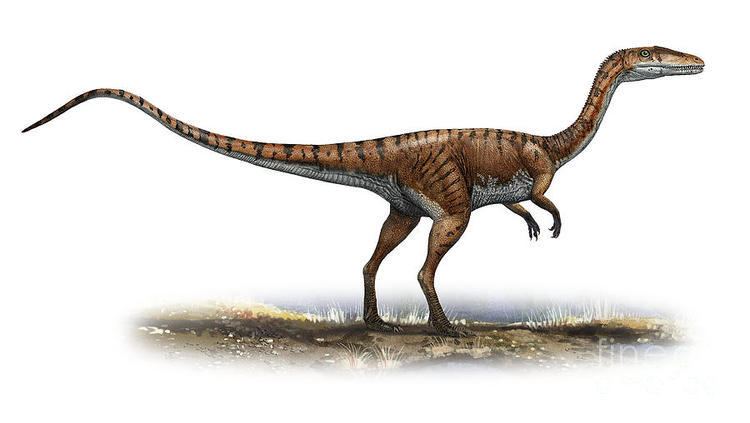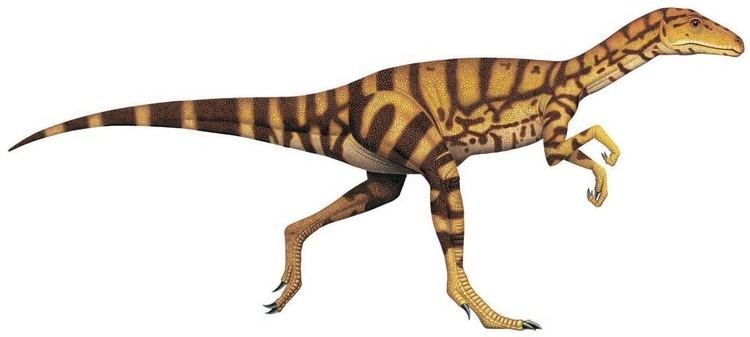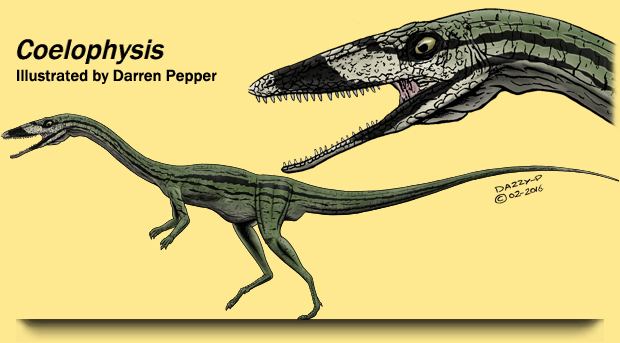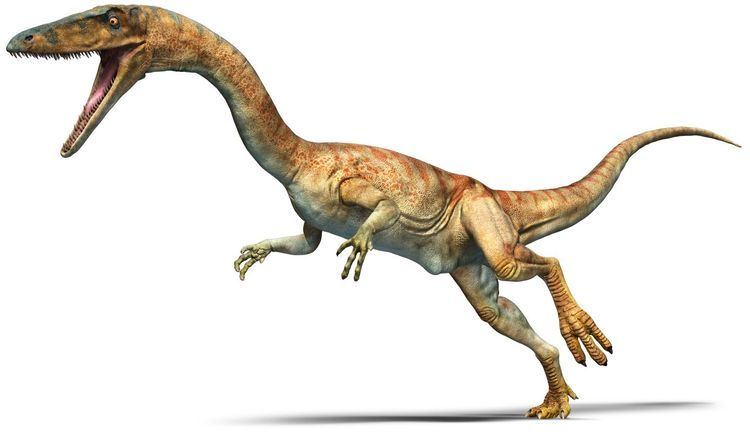Clade Dinosauria Scientific name Coelophysis Rank Genus | Higher classification Coelophysinae | |
 | ||
Similar Dinosaur, Theropods, Plateosaurus, Herrerasaurus, Eoraptor lunensis | ||
Coelophysis ancient dinosaur tdf facts
Coelophysis (/ˌsɛloʊˈfaɪsᵻs, ˌsiː-/; SEL-oh-FY-sis or SEE-low-FY-sis) is an extinct genus of coelophysid theropod dinosaur that lived approximately 203 to 196 million years ago during the latter part of the Triassic Period in what is now the southwestern United States. It was a small, slenderly-built, ground-dwelling, bipedal carnivore, that could grow up to 3 m (9.8 ft) long. Coelophysis is one of the earliest known dinosaur genera. Scattered material representing similar animals has been found worldwide in some Late Triassic and Early Jurassic formations. The type species C. bauri, originally given to the genus Coelurus by Edward Drinker Cope in 1887, was described by the latter in 1889. The names Longosaurus and Rioarribasaurus are synonymous with Coelophysis. Another dinosaur genus, Megapnosaurus, has also been considered to be a synonym. This primitive theropod is notable for being one of the most specimen-rich dinosaur genera.
Contents
- Coelophysis ancient dinosaur tdf facts
- Coelophysis roar
- DescriptionEdit
- Distinguishing anatomical featuresEdit
- History of discoveryEdit
- ClassificationEdit
- FeedingEdit
- Pack behaviorEdit
- Growth and sexual dimorphismEdit
- ReproductionEdit
- PaleopathologyEdit
- DistributionEdit
- Fauna and habitatEdit
- TaphonomyEdit
- IchnologyEdit
- In popular cultureEdit
- References

Coelophysis roar
DescriptionEdit

Coelophysis is known from a number of complete fossil skeletons of the species C. bauri, which was a lightly built dinosaur which measured up to 3 metres (9.8 ft) in length and which was more than a meter tall at the hips. Paul (1988) estimated the weight of the gracile form at 15 kg (33 lb), and the weight of the robust form at 20 kg (44 lb). Coelophysis was a bipedal, carnivorous, theropod dinosaur that was a fast and agile runner. Despite being an early dinosaur, the evolution of the theropod body form had already advanced greatly from creatures like Herrerasaurus and Eoraptor. The torso of Coelophysis conforms to the basic theropod body shape, but the pectoral girdle displays some interesting special characteristics: C. bauri had a furcula (wishbone), the earliest known example in a dinosaur. Coelophysis also preserves the ancestral condition of possessing four digits on the hand (manus). It had only three functional digits, the fourth embedded in the flesh of the hand.

Coelophysis had narrow hips, forelimbs adapted for grasping, and narrow feet. Its neck and tail were long and slender. The pelvis and hindlimbs of C. bauri are also slight variations on the theropod body plan. It has the open acetabulum and straight ankle hinge that define the Dinosauria. The hindlimb ended in a three-toed foot (pes), with a raised hallux. The tail had an unusual structure within its interlocking prezygapophysis of its vertebrae, which formed a semi-rigid lattice, apparently to stop the tail from moving up and down.

Coelophysis had a long narrow head (approximately 270 mm (0.9 ft)), with large, forward-facing eyes that afforded it stereoscopic vision and as a result excellent depth perception. Rinehart et al. (2004) described the complete sclerotic ring found for a juvenile Coelophysis bauri (specimen NMMNH P-4200), and compared it to data on the sclerotic rings of reptiles and birds and concluded that Coelophysis was a diurnal, visually oriented predator. The study found that the vision of Coelophysis was superior to most lizards' vision, and ranked with that of modern birds of prey. The eyes of Coelophysis appear to be the closest to those of eagles and hawks, with a high power of accommodation. The data also suggested poor night vision, which would mean this dinosaur had a round rather than a split pupil.

Coelophysis had an elongated snout with large fenestrae which helped to reduce skull weight, while narrow struts of bones preserved the structural integrity of the skull. The neck had a pronounced sigmoid curve. The braincase is known in Coelophysis bauri but little data could be derived because the skull was crushed. Unlike some other theropods, the cranial ornamentation of Coelophysis was not located at the top of its skull. Low, laterally raised bony ridges were present on the dorsolateral margin of the nasal and lacrimal bones in the skull, directly above the antorbital fenestra.
Distinguishing anatomical featuresEdit

A diagnosis is a statement of the anatomical features of an organism (or group) that collectively distinguish it from all other organisms. Some, but not all, of the features in a diagnosis are also autapomorphies. An autapomorphy is a distinctive anatomical feature that is unique to a given organism or group.

According to Ezcurra (2007), and Bristowe and Raath (2004) Coelophysis can be distinguished based on the following features: the absence of an offset rostral process of the maxilla; the quadrate is strongly caudally; a small external mandibular fenestra, which is 9-10% of the mandibular length; and the anteroposterior length of the ventral lacrimal process is greater than 30% of its height.

Several paleontologists consider Coelophysis bauri to be the same dinosaur as Coelophysis rhodesiensis (formerly Syntarsus, alternately Megapnosaurus), however this has been refuted by the following: Downs (2000) concluded that C. bauri differs from C. rhodesiensis in cervical length, proximal and distal hindlimb proportions and proximal caudal vertebral anatomy; Tykoski and Rowe (2004) concluded that C. bauri differs from C. rhodesiensis in that it lacks a pit at the base of the nasal process of the premaxilla; and Bristowe and Raath (2004) concluded that C. bauri differs from C. rhodesiensis in having a longer maxillary tooth row.
History of discoveryEdit
Named in 1887, the type species of Coelophysis was originally named as a species of Coelurus. Edward Drinker Cope first named Coelophysis in 1889 to name a new genus, outside of Coelurus and Tanystrophaeus to which C. bauri was previously classified in for C. bauri, C. willistoni and C. longicollis. An amateur fossil collector working for Cope, David Baldwin, had found the first remains of the dinosaur in 1881 in the Chinle Formation in northwestern New Mexico. Early in 1887 Cope referred the specimens collected to two new species, C. bauri and C. longicollis of the genus Coelurus Marsh 1879. Later in 1887 Cope reassigned the material to a yet another genus, Tanystrophaeus. Two years later, Cope corrected his classification after realizing differences in the vertebrae, and named Coelophysis, with C. bauri as the type species, which was named for Georg Baur, a comparative anatomist whose ideas were similar to Cope's. The name Coelophysis comes from the Greek words κοιλος/koilos (meaning 'hollow') and φυσις/physis (meaning 'form'), thus "hollow form" which is a reference to its hollow vertebrae. However, these first finds were too poorly preserved to give a complete picture of this new dinosaur. In 1947, a substantial 'graveyard' of Coelophysis fossils was found by George Whitaker, the assistant of Edwin H. Colbert, in New Mexico, at the Ghost Ranch, close to the original find. American Museum of Natural History paleontologist Edwin H. Colbert conducted a comprehensive study of all the fossils found up to that date and assigned them to Coelophysis. The Ghost Ranch specimens were so numerous, including many well-preserved and fully articulated specimens, that one of them has since become the diagnostic, or type specimen, for the entire genus, replacing the original, poorly preserved specimen.
ClassificationEdit
Coelophysis is a distinct taxonomic unit (genus), composed of two species; C. bauri and C. rhodesiensis (the latter formerly classified as the genus Megapnosaurus). Two additional originally described species, C. longicollis and C. willistoni, are now considered synonymous with C. bauri. C. rhodesiensis is probably part of this generic complex, and is known from the Jurassic of southern Africa. A third possible species is Coelophysis kayentakatae, previously referred to the genus Megapnosaurus. There is not a clear consensus at this point.
In the early 1990s, there was debate over the diagnostic characteristics of the first specimens collected, compared to the material excavated at the Ghost Ranch Coelophysis quarry. Some paleontologists were of the opinion that the original specimens were not diagnostic beyond themselves and, therefore, that the name C. bauri could not be applied to any additional specimens. They therefore applied a different name, Rioarribasaurus, to the Ghost Ranch quarry specimens.
Since the numerous well-preserved Ghost Ranch specimens were used as Coelophysis in most of the scientific literature, the use of Rioarribasaurus would have been very inconvenient for researchers, so a petition was given to have the type specimen of Coelophysis transferred from the poorly preserved original specimen to one of the well-preserved Ghost Ranch specimens. This would make Rioarribasaurus a definite synonym of Coelophysis, specifically a junior objective synonym. In the end, the International Commission on Zoological Nomenclature (ICZN) voted to make one of the Ghost Ranch samples the actual type specimen for Coelophysis and dispose of the name Rioarribasaurus altogether (declaring it a nomen rejectum, or "rejected name"), thus resolving the confusion. The name Coelophysis therefore became a nomen conservandum ("conserved name").
In a situation affecting many dinosaur taxa, some more recently discovered fossils were originally classified as new genera but may be species of Coelophysis. For example, Prof. Mignon Talbot's 1911 discovery which she named Podokesaurus holyokensis, has long been considered to be related to Coelophysis, and some modern scientists consider Podokesaurus a synonym of Coelophysis. Another specimen from the Portland Formation of the Hartford Basin, now at the Boston Museum of Science, has also been referred to Coelophysis. This specimen consists of sandstone casts of a pubis, tibia, three ribs, and a possible vertebra, and probably originated in a quarry in Middletown, Connecticut. However, both the type specimen of Podokesaurus and the Middletown specimen are typically considered indeterminate theropods today.
Sullivan & Lucas (1999) referred one specimen from Cope's original material of Coelophysis (AMNH 2706) to what they thought was a newly discovered theropod, Eucoelophysis. However, subsequent studies have shown that Eucoelophysis was misidentified, and is actually a primitive, non-dinosaurian ornithodiran closely related to Silesaurus.
The genus Syntarsus was named by Raath in 1969 for the type species Syntarsus rhodesiensis from Africa, and later applied to the North American Syntarsus kayentakatae. It was renamed by American entomologist Dr. Michael Ivie (Montana State University of Bozeman), Polish Australian Dr. Adam Ślipiński, and Polish Dr. Piotr Węgrzynowicz (Muzeum Ewolucji Instytutu Zoologii PAN of Warsaw), the three scientists who discovered that the genus name Syntarsus was already taken by a colydiine beetle described in 1869. Many paleontologists did not like the naming of Megapnosaurus, partially because taxonomists are generally expected to allow original authors of a name to correct any mistakes in their work. Raath was aware of the homonymy between the dinosaur Syntarsus and beetle Syntarsus, but the group who published Megapnosaurus were led to believe Raath was deceased and therefore unable to correct his mistake, and proceeded accordingly. Mortimer (2012) pointed out that "Paleontologists might have reacted more positively if the replacement name (Megapnosaurus) hadn't been facetious, translating to "big dead lizard". Yates (2005) analyzed Coelophysis and Megapnosaurus and concluded that the two genera are almost identical, and suggested that Megapnosaurus was possibly synonymous with Coelophysis. In 2004, Raath co-authored two papers in which he argued that Megapnosaurus (formerly Syntarsus) was a junior synonym of Coelophysis. Megapnosaurus was regarded by Paul (1988) and Downs (2000) as being congeneric with Coelophysis. Then in 1993, Paul suggested that Coelophysis should be placed in Megapnosaurus (then known as Syntarsus) to get around the above-mentioned taxonomic confusion. Downs (2000) examined Camposaurus and concluded that it was a junior synonym of Coelophysis, because of its similarity to some of the Coelophysis Ghost Ranch specimens. However, a reassessment of the Camposaurus holotype by Martin Ezcurra and Stephen Brusatte published in 2011 revealed a pair of autapomorphies in the holotype, indicating that C. arizonensis was not a synonym of C. bauri, although it was a close relative of C. rhodesensis.
FeedingEdit
The teeth of Coelophysis were typical of predatory dinosaurs, blade-like, recurved, sharp and jagged with fine serrations on both the anterior and posterior edges. Its dentition shows that it was carnivorous, probably preying on the small, lizard-like animals that were discovered with it. It may also have hunted in packs to tackle larger prey.Coelophysis bauri has approximately 26 teeth on the maxillary bone of the upper jaw and 27 teeth on the dentary bone of the lower jaw. Carpenter (2002) examined the bio-mechanics of theropods forelimbs and attempted to evaluate their usefulness in predation. He concluded that the forelimb of Coelophysis was flexible and had a good range of motion, but its bone structure suggested that it was comparatively weak. The "weak" forelimbs and small teeth in this genus, suggested that Coelophysis preyed upon animals that were substantially smaller than itself. Rinehart et al. agreed that Coelophysis was a "hunter of small, fast-moving prey". Carpenter also identified three distinct models of theropod forelimb use and noted that Coelophysis was a "combination grasper-clutcher" as compared to other dinosaurs that were "clutchers" or "long armed graspers".
It has been suggested that C. bauri was a cannibal, based on supposed juvenile specimens found "within" the abdominal cavities of some Ghost Ranch specimens. However, Robert J. Gay showed in 2002 that these specimens were misinterpreted. Several specimens of "juvenile coelophysids" were actually small crurotarsan reptiles such as Hesperosuchus. Gay's position was lent support in a 2006 study by Nesbitt et al. In 2009, new evidence of cannibalism came to light when additional preparation of previously excavated matrix revealed regurgitate material in and around the mouth of Coelophysis specimen NMMNH P-44551. This material included tooth and jaw bone fragments that Rinehart et al. considered "morphologically identical" to a juvenile Coelophysis.
In 2010, Gay examined the bones of juveniles found within the thoracic cavity of AMNH 7224, and calculated that the total volume of these bones was 17 times greater than the maximum estimated stomach volume of the Coelophysis specimen. Gay observed that the total volume would be even greater when considering that there would have been flesh on these bones. This analysis also noted the absence of tooth marks on the bones as would be expected in defleshing, and the absence of expected pitting by stomach acids. Finally Gay demonstrated that the alleged cannibalized juvenile bones, were deposited stratigraphically below the larger animal that supposedly cannibalized them. Taken together these data suggested that the Coelophysis specimen AMNH 7224 was not a cannibal and that the bones of the juvenile and adult specimens were found in their final position as a result of "coincidental superposition of different sized individuals.
Pack behaviorEdit
The discovery of over 1000 specimens of Coelophysis at the Whitaker quarry at Ghost Ranch, has suggested gregarious behavior to researchers like Schwartz and Gillette. There is a tendency to see this massive congregation of animals as evidence for huge packs of Coelophysis roaming the land. No direct evidence for flocking exists; the deposits only indicate that large numbers of Coelophysis, along with other Triassic animals, were buried together. Some of the evidence from the taphonomy of the site indicates that these animals may have been gathered together to feed or drink from a depleted water hole or to feed on a spawning run of fish, and then became buried in a catastrophic flash flood or a drought.
Growth and sexual dimorphismEdit
Rinehart (2009) assessed the ontogenic growth of this genus using data gathered from the length of its upper leg bone (femur) and concluded that Coelophysis juveniles grew rapidly, especially during the first year of life. Coelophysis likely reached sexual maturity between the second and third year of life and reached its full size, just above 10 feet in length, by its eighth year. This study identified four distinct growth stages: 1-year, 2-year, 4-year, and 7+ year. It was also thought, that as soon as they were hatched, they would have to fend for themselves.
Two "morphs" of Coelophysis have been identified: a more gracile form, as in specimen AMNH 7223, and a slightly more robust form, as in specimens AMNH 7224 and NMMNH P-42200. Skeletal proportions were different between these two forms; the gracile form has a longer skull, a longer neck, shorter forelimbs, and has sacral neural spines that are fused; and the robust form has a shorter skull, a shorter neck, longer forelimbs, and unfused sacral neural spines. Historically, many arguments have been made that this represents some sort of dimorphism in the population of Coelophysis, probably sexual dimorphism. Raath agreed that dimorphism in Coelophysis is evidenced by the size and structure of the forelimb. Rinehart et al. studied 15 individuals, and agreed that two morphs were present, even in juvenile specimens, and suggested that sexual dimorphism was present early in life, prior to sexual maturity. Rinehart concluded that the gracile form was female and the robust form was male based on differences in the sacral vertebrae of the gracile form, which allowed for greater flexibility for egg laying. Further support for this position was provided by an analysis showing that each morph comprised 50% of the population, as would be expected in a 50/50 sex ratio.
However, more recent research has found that C. bauri and C. rhodesiensis had highly variable growth between individuals, with some specimens being larger in their immature phase than smaller adults were when completely mature; this indicates that the supposed presence of distinct morphs is simply the result of individual variation. This highly variable growth was likely ancestral to dinosaurs but later lost, and may have given such early dinosaurs an evolutionary advantage in surviving harsh environmental challenges.
ReproductionEdit
Through the compilation and analysis of a database of nearly three dozen birds and reptiles, and comparison with existing data about the anatomy of Coelophysis Rinehart et al. (2009) drew the following conclusions. It was estimated that average egg of Coelophysis was 31-33.5 millimeters across its minor diameter, and that each female would lay between 24-26 eggs in each clutch. The evidence suggested that some parental care was necessary to nurture the relatively small hatchlings during the first year of life, where they would reach 1.5 meters in length by the end of their first growth stage. Coelophysis bauri invested as much energy in reproduction as other extinct reptiles of its approximate size.
PaleopathologyEdit
In a 2001 study conducted by Bruce Rothschild and other paleontologists, 14 foot bones referred to Coelophysis were examined for signs of stress fracture, but none were found.
DistributionEdit
Specimens of Coelophysis have been recovered at the Ghost Ranch (Whitaker) quarry of the Chinle Formation in New Mexico, and the Petrified Forest Member of the Chinle Formation in Arizona and New Mexico. In Ghost Ranch, Coelophysis was discovered in sediments deposited during the Norian stage of the Upper Triassic, which have been dated to approximately 203 million years old. In the Petrified Forest Member of the Chinle Formation, this genus was discovered in strata that are from the Norian stage of the Late Triassic.
Fauna and habitatEdit
Ghost Ranch was located close to the equator 200 million years ago, and had a warm, monsoon-like climate with heavy seasonal precipitation. Hayden Quarry, a new excavation site at Ghost Ranch, New Mexico, has yielded a diverse collection of fossil material that included the first evidence of dinosaurs and less-advanced dinosauromorphs from the same time period. The discovery indicates that the two groups lived together during the early Triassic period 235 million years ago.
Therrien and Fastovsky (2001) examined the paleoenvironment of Coelophysis and other early theropods from Petrified Forest National Park in Arizona, and determined that this genus lived during the Late Triassic in an environment that consisted of floodplains marked by distinct dry and wet seasons. There was a great deal of competition during drier times when animals struggled for water in riverbeds that were drying up. The contemporary archosaurs of Coelophysis in Chinle Formation were the crurotarsan Revueltosaurus; the phytosaurs Leptosuchus, Paleorhinus, Machaeroprosopus, Redondasaurus and possibly Rutiodon; several aetosaurs, including Acaenasuchus, Desmatosuchus, Paratypothorax, Stagonolepis, and Typothorax; the crocodilomorphs Hesperosuchus, and Parrishia; the rauisuchians Shuvosaurus, Effigia, Poposaurus, Postosuchus, and Saurosuchus; the dinosauriform Eucoelophysis; and the dinosaurs Chindesaurus, Camposaurus, Daemonosaurus, and Gojirasaurus. Coelophysis also lived alongside the archosauromorphs Crosbysaurus, Tanytrachelos, Tecovasaurus, Trilophosaurus, and Vancleavea; the other amniotes Acallosuchus, Colognathus, Kraterokheirodon, Placerias, and Uatchitodon; the amphibians Apachesaurus, and Koskinonodon; and the fish Acrodus, Lonchidion, Phoebodus, Reticulodus, Xenacanthus, Chinlea, Arganodus, Australosomus, Lasalichthyes, and Turseodus.
TaphonomyEdit
The multitude of specimens deposited so closely together at Ghost Ranch was probably the result of a flash flood, which swept away a large number of Coelophysis and buried them quickly and simultaneously. In fact, it seems that such flooding was commonplace during this period of the Earth's history and, indeed, the Petrified Forest of nearby Arizona is the result of a preserved log jam of tree trunks that were caught in one such flood. Whitaker quarry at Ghost Ranch is considered a monotaxic site because it features multiple individuals of a single taxon. The quality of preservation and the ontogenic (age) range of the specimens helped make Coelophysis one of the best known of all genera. In 2009, Rinehart et al. noted that in one case the Coelophysis specimens were "washed into a topographic low containing a small pond, where they probably drowned and were buried by a sheet flood event from a nearby river."
IchnologyEdit
Edwin H. Colbert has suggested that the theropod footprints referred to the ichnogenus Grallator, located in the Connecticut River Valley across Connecticut and Massachusetts, may have been made by Coelophysis. The footprints are from the Late Triassic to Early Jurassic aged Newark Supergroup. They clearly show digits II III and IV but not I or V. That condition is strange for footprints of their age. The digits were presumed to be stubby and ineffective, not touching the ground when the dinosaur was walking or running. They have been thought to be from an unidentified, primitive saurischian similar to Coelophysis by David B. Weishampel and L. Young more recently. Skeletal remains resembling Coelophysis have also been found in the valley, supporting the idea that a species similar to Coelophysis is responsible for the footprints.
In popular cultureEdit
Coelophysis was the second dinosaur in space, following Maiasaura (STS-51-F). A Coelophysis skull from the Carnegie Museum of Natural History was aboard the Space Shuttle Endeavour mission STS-89 when it left the atmosphere on January 22, 1998. It was also taken onto the space station Mir before being returned to Earth.
As being over 100 years old, Coelophysis is one of the best-known dinosaurs in literature. It was designated as the official state fossil of New Mexico, and is now the logo of the New Mexico Museum of Natural History.
Coelophysis also appeared in the first episode of the BBC series Walking with Dinosaurs, where they, along with other extinct species, were recreated using CGI animation and animatronics.
